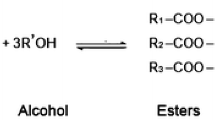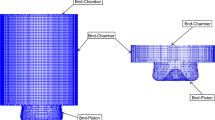Abstract
In the current study, effect of chamber ambient backpressures and temperatures on non-reacting fuel spray characteristics of heavy fuel oil (HFO) under high pressure injection is numerically studied. Four different chamber backpressures ranging from 0.05 up to 2.8 MPa at two different ambient temperatures have been considered in a medium speed engine. An Eulerian-Lagrangian multiphase scheme is implemented to model HFO interaction with air continuous phase by using Open source CFD toolbox of OpenFOAM. Numerical results of fuel spray are validated with good accordance against existing experimental data. Based on the computational findings, enhancement of chamber backpressure results in reduction of temporal spray penetration and increase of spray cone angle at both ambient temperatures. Furthermore, the SMD is found to decrease due to enhancement of chamber backpressures up to 1.4 MPa. Finally, it was found that higher ambient temperature increases the spray penetration length at all chamber backpressures.
Similar content being viewed by others
Abbreviations
- HFO:
-
heavy fuel oil
- PM:
-
particulate matter
- RAS:
-
reynolds averaged simulation
- RANS:
-
reynolds averaged navier stokes
- RMSE:
-
root mean square error
- ASOI:
-
after start of injection
- SMD:
-
sauter mean diameter
- PISO:
-
pressure implicit with splitting of operator
- SIMPLE:
-
semi implicit method for pressure linked equations
- LPT:
-
lagrangian particle tracking
- S i,mo :
-
interaction with the spray liquid phase as a source term
- S he :
-
heat transferred from the liquid phase as a source term
- Pr:
-
prandtl number
- X f :
-
mass fraction of fuel
- \(\dot f\) CO :
-
contribution due to the effects of collision of the droplets
- \(\dot f\) br :
-
contribution due to the effects of droplets breakup
References
Aneja, R. and Abraham, J. (1998). How far does the liquid penetrate in a diesel engine: Computed results vs. measurements? Combustion Science and Techechnology, 138, 233–255.
Chen, X., Liu, Y. and Yang, V. (2011). Effect of backpressure on internal flow dynamic and spray characteristics of liquid swirl injector. 49th AIAA Aerospace Sciences Meeting including the New Horizons Forum and Aerospace Exposition, Orlando, Florida, USA.
Chryssakis, C., Pantazis, K. and Kaiktsis, L. (2010). Combustion modeling with heavy fuel oil for large marine diesel engine applications. CIMAC Cong., Bergen, Norway.
Fink, C., Buchholz, B., Niendorf, M. and Harndorf, H. (2008). Injection spray analyses from medium speed engines using marine fuels. ILASS, Como Lake, Italy.
Garcia-Oliver, J. M., Pastor, J. M. and Pandal, M. (2013). Diesel spray CFD simulations based on the Σ-Y eulerian atomization. Atomization and Sprays 23, 1.
Ghasemi, A. and Djavareshkian, M. H. (2010). Investigation of the effects of natural gas equivalence ratio and piston bowl flow field on combustion and pollutant formation of a DI dual fuel engine. J. Applied Sciences 10, 14, 1369–1379.
Ghasemi, A., Fukuda, K., Balachandar, R. and Barron, R. (2012). Numerical investigation of spray characteristics of diesel alternative fuels. SAE Paper No. 2012-01-1265.
Ghasemi, A., Barron, R. M. and Balachandar, R. (2013). Spray-induced air motion in single and twin ultra-high injection diesel sprays. Fuel, 121, 287–297.
Gjesing, R., Hattel, J. and Fritsching, U. (2009). Coupled atomization and spray modeling in the spray forming process using OpenFOAM. Engineering Applications of Computational Fluid Mechanics 3, 4, 471–486.
Goldsworthy, L. (2005). Computational fluid dynamics modelling of residual fuel oil combustion in the context of marine diesel engines. Int. J. Engine Res., 7.
Herrmann, K., Kyrtatos, A., Schulz, R. and Weisser, G. (2009). Validation and initial application of a novel spray combustion chamber representative of large two-stroke diesel engine combustion systems. ICLASS, Colorado, USA.
Ismail, H. M., NG, H. K. and Cheng, X. (2012). Development of thermophysical and transport properties for the CFD simulations of in-cylinder biodiesel spray combustion. Energy Fuels, 26, 4857–4870.
Ismail, H. M., NG, H. K., Gan, S. and Lucchini, T. (2013). Computational study of biodiesel-diesel fuel blends on emission characteristics for a light-duty diesel engine using OpenFOAM. Applied Energy, 111, 827–841.
Jiang, X., Siamas, G. A., Jagus, K. and Karayiannis, T. G. (2010). Physical modelling and advanced simulations of gas-liquid two-phase jet flows in atomization and sprays. Progress in Energy and Combustion Science 36, 2, 131–167.
Kassem, H. I., Saqr, K. M., Aly, H. S., Sies, M. M. and Wahid, M. A. (2011). Implementation of the eddy dissipation model of turbulent non-premixed combustion in OpenFOAM. Int. Communications in Heat and Mass Transfer, 38, 363–367.
Kim, H. M., Cho, W. J. and Lee, K. H. (2008). Effect of injection condition and swirl on D.I. diesel combustion in a transparent engine system. Int. J. Automotive Technology 9, 5, 535–541.
Kyriakides, N., Chryssakis, C. and Kaiktsis, L. (2009). Influence of heavy fuel properties on spray atomization for marine diesel engine applications. SAE Paper No. 2009-01-1858.
Lee, C. S. and Park, S. W. (2002). An experimental and numerical study on fuel atomization characteristics of high-pressure diesel injection sprays. Fuel 81, 18, 2417–2423.
Park, S. H., Kim, H. J. and Lee, C. S. (2010). Comparison of experimental and predicted atomization characteristics of high-pressure diesel spray under various fuel and ambient temperature. J. Mechanical Science and Technology 24, 7, 1491–1499.
Pickett, L., Manin, J., Payri, R. and Bardi, M. (2013). Transient rate of injection effects on spray development. SAE Paper No. 2013-24-0001.
Pickett, L. M., Genzale, C. L., Manin, J., Malbec, L. M. and Hermant, L. (2011). Measurment uncertainlt of liquid penetration in evaporating diesel sprays. ILASS, CA, USA.
Poinsot, T. and Veynante, D. (2005). Theoretical and Numerical Combustion. Philadelphia. Edwards.
Prathan, S., Chareonphonphanich, C., Piyaboot, O., Chollacoop, P. K. N. and Tongroon, M. (2011). Spray characteristics of ethanol and gasoline in a high-pressure chamber by schlieren photography technique. 2nd TSME Int. Conf. Mechanical Engineering, Krabi, Thailand.
Rakopoulos, C. D., Rakopoulos, D. C., Hountalas, D. T., Kakaras, E. C., Giakoumis, E. G. and Papagiannakis, R. G. (2010). Investigation of the performance and emissions of bus engine operating on butanol/diesel fuel blends. Fuel, 89, 2781–2790.
Rakopoulos, D. C., Rakopoulos, C. D., Giakoumis, E. G., Dimaratos, A. M. and Kyritsis, D. C. (2010). Effects of butanol-diesel fuel blends on the performance and emissions of a high-speed DI diesel engine. Energy Conversion and Management, 51, 1989–1997.
Rakopoulos, D. C., Rakopoulos, C. D., Papagiannakis, R. G. and Kyritsis, D. C. (2011). Combustion heat release analysis of ethanol or n-butanol diesel fuel blends in heavy-duty DI diesel engine. Fuel, 90, 1855–1867.
Reitz, R. D. and Diwakar, R. (1986). Effect of drop breakup on fuel sprays. SAE Paper No. 860469.
Roisman, I. V., Araneo, L. and Tropea, C. (2007). Effect of ambient pressure on penetration of a diesel spray. Int. J. Multiphase Flow 33, 8, 904–920.
Sorusbay, C., Imren, A. and Ergeneman, M. (2009). Experimental and numerical investigation of diesel spray behavior in high pressure common-rail systems. Int. J. Vehicle Design, 50, 14.
Stamoudis, N., Chryssakis, C. and Kaiktsis, L. (2014). A two-component heavy fuel oil evaporation model for CFD studies in marine diesel engines. Fuel, 115, 145–153.
Struckmeier, D., Tsuru, D., Kawauchi, S. and Tajima, H. (2009). Multi-component modeling of evaporation, ignition and combustion processes of heavy residual fuel oil. SAE Paper No. 2009-01-2677.
Wang, X., Huang, Z., Abiola Kuti, O., Zhang, W. and Nishida, K. (2010). Experimental and analytical study on biodiesel and diesel spray characteristics under ultrahigh injection pressure. Int. J. Heat and Fluid Flow 31, 4, 659–666.
Williams, F. A. (1985). Combustion Theory. Addison-Wesley. Redwood City. CA.
Yang, G. X. and Chin, J. S. (1990). Experimental study of the effect of high back-pressure on the atomization of a plain jet injector under coaxial air flow. Aerosol Science and Technology 12, 4, 903–910.
Yao, M., Wang, H., Zheng, Z. and Yue, Y. (2010). Experimental study of n-butanol additive and multiinjection on HD diesel engine performance and emissions. Fuel, 89, 2781–2790.
Zhang, Z. H. and Balasubramanian, R. (2014). Influence of butanol- diesel blends on particulate emissions of a nonroad diesel engine. Fuel, 118, 130–136.
Author information
Authors and Affiliations
Corresponding author
Rights and permissions
About this article
Cite this article
Yousefifard, M., Ghadimi, P. & Nowruzi, H. Numerical investigation of the effects of chamber backpressure on HFO spray characteristics. Int.J Automot. Technol. 16, 339–349 (2015). https://doi.org/10.1007/s12239-015-0036-z
Received:
Revised:
Accepted:
Published:
Issue Date:
DOI: https://doi.org/10.1007/s12239-015-0036-z




